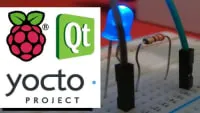
IoT Microcontrollers: Onboarding a Raspberry Pi Using Raspbian 
This video provides a step-by-step guide to onboarding a Raspberry Pi r3 B+ and setting up data flow into AWS IoT Core using Raspbian. Learn how to get started with IoT microcontrollers and the Raspberry Pi. ▼
ADVERTISEMENT
Course Feature
![]() Cost:
Cost:
Free Trial
![]() Provider:
Provider:
Pluralsight
![]() Certificate:
Certificate:
Paid Certification
![]() Language:
Language:
English
![]() Start Date:
Start Date:
On-Demand
Course Overview
❗The content presented here is sourced directly from Pluralsight platform. For comprehensive course details, including enrollment information, simply click on the 'Go to class' link on our website.
Updated in [March 06th, 2023]
This course provides an overview of the process of onboarding a Raspberry Pi r3 B+ and enabling data to flow into AWS IoT Core. Participants will learn how to set up the Raspberry Pi, install Raspbian, and configure the device to connect to AWS IoT Core. Additionally, participants will learn how to use the AWS IoT Core console to monitor the device and view data sent from the Raspberry Pi. By the end of the course, participants will have a better understanding of how to use the Raspberry Pi and AWS IoT Core to create an Internet of Things (IoT) application.
[Applications]
After completing this course, the user should be able to apply the knowledge gained to onboard other Raspberry Pi devices and enable data to flow into AWS IoT Core. Additionally, the user should be able to use the Raspberry Pi to create and deploy IoT applications. Furthermore, the user should be able to use the Raspberry Pi to create and deploy IoT applications that can be used to monitor and control physical devices. Finally, the user should be able to use the Raspberry Pi to create and deploy IoT applications that can be used to monitor and control physical devices and collect data from them.
[Career Paths]
1. IoT Developer: IoT developers are responsible for designing, developing, and deploying IoT solutions. They must have a strong understanding of hardware, software, networking, and cloud computing. They must also be able to develop applications that can interact with the physical world. As the demand for IoT solutions continues to grow, the need for experienced IoT developers is expected to increase.
2. IoT Security Engineer: IoT security engineers are responsible for ensuring the security of IoT systems. They must have a strong understanding of security protocols, encryption, authentication, and access control. They must also be able to identify and mitigate potential security threats. As the number of connected devices continues to grow, the need for experienced IoT security engineers is expected to increase.
3. IoT Data Scientist: IoT data scientists are responsible for analyzing and interpreting data from connected devices. They must have a strong understanding of data analysis, machine learning, and artificial intelligence. They must also be able to develop algorithms and models that can extract insights from large datasets. As the amount of data generated by connected devices continues to grow, the need for experienced IoT data scientists is expected to increase.
4. IoT Solutions Architect: IoT solutions architects are responsible for designing and implementing IoT solutions. They must have a strong understanding of hardware, software, networking, and cloud computing. They must also be able to develop architectures that can support the scalability and reliability of IoT solutions. As the demand for IoT solutions continues to grow, the need for experienced IoT solutions architects is expected to increase.
[Education Paths]
1. Computer Science Degree: A computer science degree is a great way to learn the fundamentals of programming, networking, and hardware design. With the rise of the Internet of Things (IoT), computer science degrees are becoming increasingly important for those looking to develop and maintain IoT systems. This degree will provide learners with the skills necessary to develop and maintain IoT systems, as well as the knowledge to understand the underlying principles of the technology.
2. Electrical Engineering Degree: Electrical engineering degrees are becoming increasingly important for those looking to develop and maintain IoT systems. This degree will provide learners with the skills necessary to develop and maintain IoT systems, as well as the knowledge to understand the underlying principles of the technology. Additionally, electrical engineering degrees are becoming more popular as the demand for IoT systems increases.
3. Robotics Degree: Robotics degrees are becoming increasingly important for those looking to develop and maintain IoT systems. This degree will provide learners with the skills necessary to develop and maintain IoT systems, as well as the knowledge to understand the underlying principles of the technology. Additionally, robotics degrees are becoming more popular as the demand for IoT systems increases.
4. Cybersecurity Degree: Cybersecurity degrees are becoming increasingly important for those looking to develop and maintain IoT systems. This degree will provide learners with the skills necessary to develop and maintain IoT systems, as well as the knowledge to understand the underlying principles of the technology. Additionally, cybersecurity degrees are becoming more popular as the demand for IoT systems increases.
Course Provider

Provider Pluralsight's Stats at AZClass
Pluralsight ranked 16th on the Best Medium Workplaces List.
Pluralsight ranked 20th on the Forbes Cloud 100 list of the top 100 private cloud companies in the world.
Pluralsight Ranked on the Best Workplaces for Women List for the second consecutive year.
AZ Class hope that this free trial Pluralsight course can help your Raspberry Pi skills no matter in career or in further education. Even if you are only slightly interested, you can take IoT Microcontrollers: Onboarding a Raspberry Pi Using Raspbian course with confidence!
Discussion and Reviews
0.0 (Based on 0 reviews)
Explore Similar Online Courses

Prototyping Virtual Reality Experiences with Unity

English&French Translator: Long Short Term Memory Networks

Python for Informatics: Exploring Information

Social Network Analysis

Introduction to Systematic Review and Meta-Analysis

The Analytics Edge

DCO042 - Python For Informatics

Causal Diagrams: Draw Your Assumptions Before Your Conclusions

Whole genome sequencing of bacterial genomes - tools and applications

Powering your Home Projects with Raspberry Pi

Creative Audio Programming on the Raspberry Pi


Start your review of IoT Microcontrollers: Onboarding a Raspberry Pi Using Raspbian